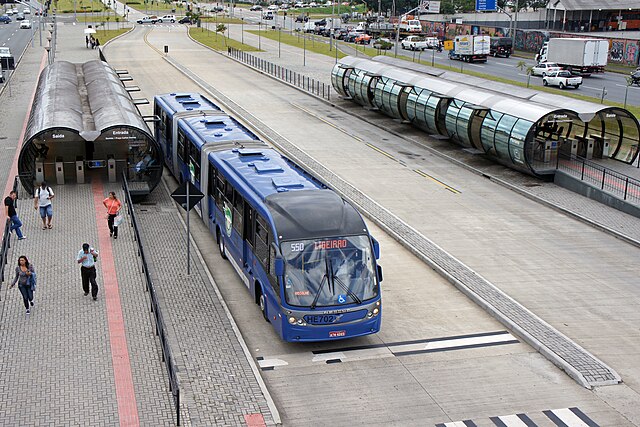大眾運輸系統 来自维基百科,自由的百科全书
快捷巴士系统(英语:Bus Rapid Transit,缩写为BRT),是一种以巴士为基础而发展成的大运量快速客运系统。一个完整的快捷巴士系统应具有专门的设计、服务和基础设施,以提高系统的品质以排除可能误点的因素。快捷巴士系统起源于拉丁美洲,且于该地有许多成功案例,例如巴西库里蒂巴、哥伦比亚波哥大,其结合地铁与轻轨的容量、速度与巴士系统的低成本、灵活性和简单性,并能提供近似铁路的服务水准,被喻为“地面上的地铁”。[2]
此条目需要精通或熟悉相关主题的编者参与及协助编辑。 |
| “快捷巴士系统”的各地常用名称 | |
|---|---|
| 中国大陆 | 快速公交系统 |
| 台湾 | 公车捷运系统 |
| 港澳 | 巴士快速交通系统 |
| 马来西亚 | 快捷巴士系统 |



统计至2018年3月止,世界六大洲共有166座城市设置快捷巴士系统,其线路总长约为4,906公里(3,048英里)[3]。据估计,快捷巴士系统于全世界每天约有3,220万旅次使用,其中以拉丁美洲为主,每天约有1,960万旅次使用,是世上最多的区域。拉丁美洲亦是快捷巴士系统最发达的地方,总共设置54座,其中巴西就占了21座[3] 。单日载客量最多的拉丁美洲国家依序为巴西(1,070万)、哥伦比亚(306万)和墨西哥(250万)。在其他地区,中国大陆(430万)和伊朗(210万)也相当杰出[3] 。目前,印尼的雅加达专线巴士被认为是世界上最大的BRT路网,大约有251.2公里(156.1英里)的路廊在雅加达首都特区穿梭[1]。
身为2020东京奥运的主办国,日本政府规划了BRT专用车道以解决奥运期间的交通问题,东京BRT专用道将设置在选手村与各场馆之间进行接驳。[4]
美国罗德岛普罗维登斯的东侧无轨电车隧道(East Side Trolley Tunnel)是世界上第一条巴士专用道,1948年该隧道由无轨电车转供巴士使用。但世界上第一座BRT系统则由加拿大渥太华的渥太华卡尔顿交通局(OC Transpo)于1973年推出。其具有BRT的的第一个要件——专用道,该专用道穿过市中心并设有站台供巴士停靠。1983年引进专用且分隔式的巴士专用道(称为“Transitway”)。1996年,最初计划长31公里的巴士专用道系统都已启用运营;且分别于2009年、2011年和2014年扩张。2019年,Transitway的中心部分已被改建为轻轨,原因是市中心区的载客量已超出原先计划所能负荷的上限[5]。

1974年巴西库里奇巴(Curitiba)启用整合交通网(Rede Integrada de Transporte, RIT),是世界第二座BRT系统[6]:5[7]。 BRT相关的大多数要件都是由建筑师暨时任库里奇巴市长杰梅勒纳(Jaime Lerner)首先提出[8][9]。最初只在市中心主要干道设置巴士专用道,但1980年库里奇巴BRT新增支线巴士与社区路网,更于1992年引进站外收费、封闭式车站和无阶化乘车。巴西其他BRT甚至有进一步的创新,包括在阿雷格里港采用列队行驶(三辆巴士同时进出车站但只使用一组交通灯进行控制),而圣保罗则是增建通过车道并运行特快车等不同的运行模式[10]。
在美国,BRT起于匹兹堡,1977年该市开始运营总长4.3英里的南巴士专用道(South Busway) [11]。它的成功促成了1983年小马丁·路德·金恩东巴士专用道( Martin Luther King Jr. East Busway )的设置,该系统提供其中包括9.1英里(14.6公里)的巴士专用道、优先号志以及经高峰时段间隔2分钟发车的服务。在1990年全长5.1英里(8.2公里)的西巴士专用道(West Busway)开业后,匹兹堡的巴士专用道系统现已超过18.5英里长。
2004年1月,东南亚第一座BRT系统雅加达专线巴士在印尼雅加达开业。统计至2015年,其路网总长210公里(130英里),是世界上最长的BRT系统[12]。
2004年12月25日,中国第一条快捷巴士线路北京快捷巴士1号线开通试运营,早期由前门开往木樨园,2005年12月30日延长至德茂庄。
非洲的第一个BRT系统于2008年3月在尼日利亚拉各斯开业,但被许多人视为轻型BRT系统[13]。约翰内斯堡的BRT雷亚法雅 (Rea Vaya)开业于2009年8月,每天运送16,000名乘客,是非洲第一座真正的BRT。Rea Vaya和MIO(哥伦比亚卡利的BRT,于2009年开业)是前两个结合完整BRT与其他交通所提供的服务,并将其整合BRT主干基础设备的系统[14] 。




专用车道可确保巴士能够高速行驶,且能避开交通堵塞。设置于道路正中央的专用道更能使巴士不受路侧交通干扰(例如要转弯或者要停靠的车辆),也有将路权升至A级的BRT,例如厦门BRT、成都市二环路BRT皆采高架化,车辆行驶于专用的高架桥之上。部分城市甚至禁止私有机动车辆行驶特定路段,并设置公共交通专用区(transit malls)或巴士街(bus streets),仅允许行人或脚踏车进入并换乘巴士。
利用站内收费机闸,免除乘客一一刷卡与投币、剪票的时间。
包括优先号志系统(透过对交通灯时相的控制,延长绿灯或者是缩短红灯秒数,减少BRT车辆在号志化路口停等的时间,并确保准点率),并禁止其他车辆左右转向或跨越专用道以减少对BRT车道的车流交织。
巴士地板与站体站台的无高低差,并可以多门同时进出(节省排队上车、爬上爬下的时间,并形成无障碍友善空间)



由于部分BRT系统规划不当或配套时机不成熟,在地面建造后占用部分道路资源,造成交通更加拥堵,如郑州BRT的站台占用社会车道,造成交通堵塞[17]。部分地区,自用车侵占BRT专用道,影响BRT的运输效率下降,如南宁[18];部分地区的客流量较低,上座率不高,浪费了道路资源,如重庆[19]。再比如,曼谷BRT由于占用城市道路使曼谷道路拥堵情况更加严重,加之每年两亿泰铢的亏损,因此曼谷市政府决定将曼谷快捷巴士系统于2017年4月正式停运[20][21]。
Seamless Wikipedia browsing. On steroids.